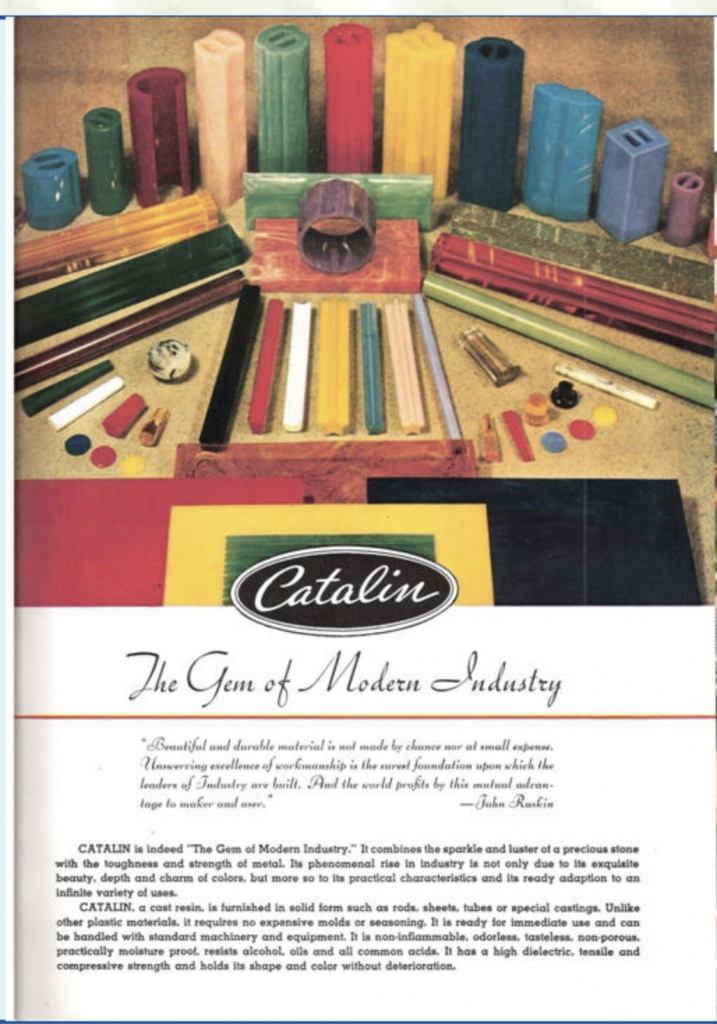by Albert Steg
Vintage bakelite checkers are currently in high demand among players looking to put together their ideal backgammon set. Bakelite is a broadly generic term for a novel, highly durable synthetic material developed in the early 20th century, made from phenol and formaldehyde. In 1927 the American Catalin Company began adding new color processes to the formula in order to produce the bright, dazzling species of bakelite that became popular in Jazz-age jewelry and various household items. By coincidence, backgammon enjoyed a major American boom at just that time, and the result was a lot of dazzling checker sets being produced from 1927 through the post-war period, by which time bakelite began to be superseded by other varieties of synthetic plastics, and was eventually phased out due to health hazards involved with its production.
What makes bakelite so desirable? It’s not just the vivid colors, the lustrous beauty and variety of swirling textures, or the added visual interest that a carved pattern might bring to your table: it’s also the unusual density of the material that gives them a satisfying weight in your hand. Pick up a few of them with one hand and an equal number of modern synthetic checkers with the other, and you’ll feel a difference as you jostle them around in your palm. You’ll hear a difference too — the sound of bakelite checkers in play, tapping against each other or on the hard rails of a board frame adds a further dimension of sensual pleasure to the game. Plastic clicks; bakelite clacks.
This page is best viewed on a wide browser screen.
Checker Variations
Color & Carving
There is great variety of colors in bakelite, but also a family resemblance in its depth and brilliance. The “Blue Moon” color is particularly rare and highly prized by collectors. Carving styles can add further visual and tactile appeal, and, along with color swirling, can help checkers stand out against similar-colored fields or points. However, uncarved checkers have the most weight, and provide a more blocky, heavy feel that many find appealing. Checkers range in size from tiny .75″ travel pieces to hefty 2″ goliaths.
Checker Edges
It’s worth noticing too how your checkers look from the side, as they rest in your checker tray. The distinctive edge patterns of swirled bakelite checkers is easy to spot and often a clear indicator that you’re seeing the genuine material in auction pictures. Carved edges are very rare and sought after by collectors.
Mouse-over the images to view commentary.
Variations Within Sets
Variations from checker to checker within a set are part of the bakelite allure. While it’s normal even for checker sets with fairly uniform pieces to have some variation in shade, certain sets have such exquisitely distinct color stylings that each checker seems gem-like. The green checkers pictured here are exceptional even among bakelite sets.
Cracks & Discoloration
Bakelite checkers and doubling cubes sometimes develop hairline cracks that admit air to the interior, resulting in discoloration. It’s a matter of taste whether you find these flaws unappealing, but you needn’t worry that a checker will break in two along one of these fault lines.
The surrounding images illustrate some of the salient features and distinctive details that make bakelite checker sets so highly prized.
When purchasing checkers for practical use, you should aim to buy a matched set of 30 checkers. It can be very difficult to marry two sets of 15 checkers acquired from different sources due to seemingly minor differences in dimensions or style that turn out to be significant.
Translucent Bakelite
Catalin introduced translucent options along with the wide variety of colors in the late 1920’s. Under normal playing conditions you won’t tend to notice much, but on closer view you’re able to see into some checkers. The image here was taken on a lightbox.
Patina
A distinctive feature of bakelite is that it typically acquires a patina that deepens the original colors over time. Experienced collectors of decorative items know to be wary of removing the patina from antiques and collectibles, due to the risk of damaging the underlying finish but also because the distinctive look of a patina built up over decades or centuries contributes to its beauty and is in itself the clearest evidence of age. When the item is particularly rare or culturally significant, so that the owner could be regarded as a steward of history, the decision to clean or restore it takes on an ethical dimension. Though it can be hard to find just the style or size you’re looking for, bakelite backgammon pieces survive in large quantities, so the decision whether to take aggressive measures in polishing them will be mostly a personal and aesthetic preference.
For hand cleaning, you can use Novus plastic polishes or any of the gentler metal polishes like Simichrome without affecting the patina very much. For more dramatic high-gloss / brightening results you’d probably need to use a mechanical buffer unless you have strong hands and a lot of patience. But if you go the mechanical route that substantially removes the patina, be ready for a change that may or may not please you. You can never be sure how bakelite pieces will look when you’re done stripping them down. Opaque checkers can become translucent. You can also wind up meaningfully changing the shape or dimensions of pieces by over-polishing. Carved edges will soften, and a doubling cube may no longer be so cubical.
Below are two doubling cubes I sent to Crisloid for a beauty treatment — a tumble in the proprietary mixture of crushed walnut shells and special wax solution they use for finishing their game pieces. I have found this treatment removes dulling surface scratches without deforming checkers, resulting in sparkling colors. The cubes in the picture show some of the more dramatic changes in color I’ve received from this treatment.
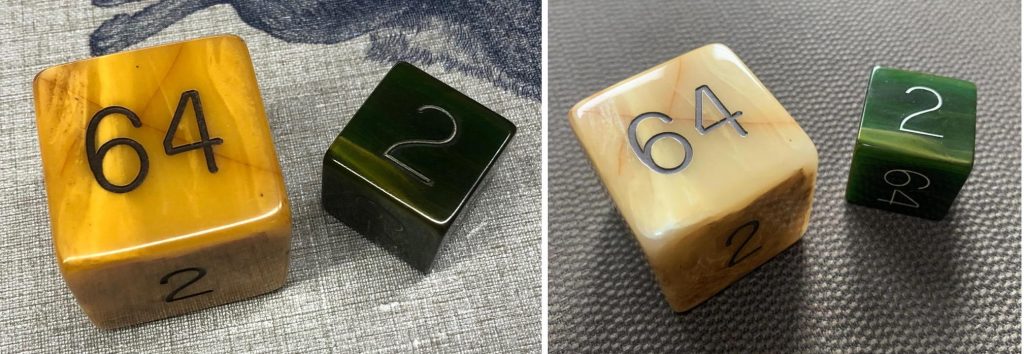
Before & After: Two cubes polished with crushed walnut and wax in the finishing tumblers at Crisloid around 2019.
The larger cube I sent partly as an experiment, as I had another just like it and I thought the contrast would be interesting. I was stunned and delighted by the new light-blond aspect of the cube, finding its mate rather dingy by new comparison. I wondered whether further polishing might bring it to a pure white state, but it’s one of my favorite cubes now as it is so I’m not curious enough to try it. The smaller cube was simply too dark and illegible to be useful over the board, but the polishing (and repainting of the numerals) has transformed it into a green beauty. I sent also a very dark “midnight blue” cube for polishing, but while some of the swirls became more visible, the change in color was not profound. For an example of radical color change brought on by oxidation, check out this video of a poker chip caddy that started life blue and wound up green. You just never know.
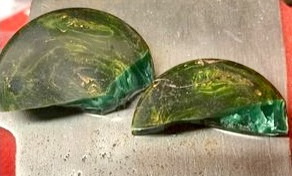
Photo courtesy Jamie Weinstein.
In the picture of a cracked-open checker at right you can see the contrast between the sharp green and white coloration on the interior and the darker, yellowed tones on the surface owing to the patina. It’s hard to imagine this entire checker ever having looked like the interior, or that the ubiquitous yellow bakelite checkers you see in the vast majority of vintage sets were once white — but if you need convincing, check out this short video illustrating the transformation of backgammon checkers into beads.
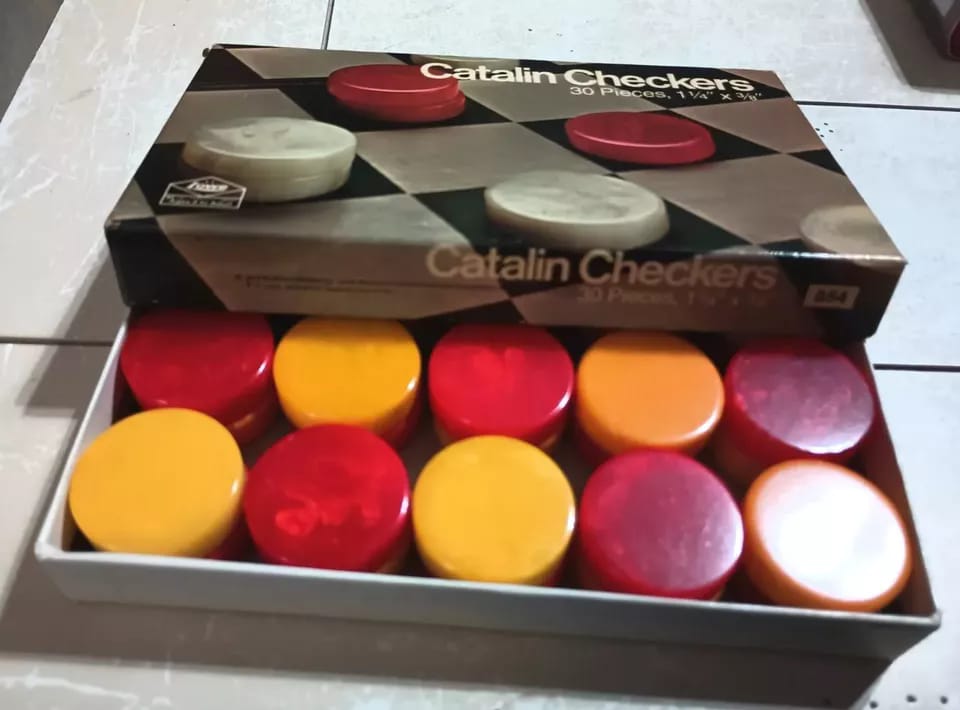
photo: ebay
The illustrated box of E.S. Lowe checkers at left also confirms that these familiar Bakelite checkers began life white, not yellow. It’s anybody’s guess how long it took for the pieces to turn so thoroughly yellow. The typography on the box looks to be from the 1970’s, but finished pieces can sit in inventory for years or even decades before reaching the checkout counter. Just visible on the front flap is the inventory number 854, tying these pieces to perennial Lowe Games catalogue entries for Catalin Checkers dating all the way back to the 1940’s (see clipping below). These catalogues offer “Red and White” as the sole color option.

This ‘854’ entry was discovered in E.S. Lowe Catalogues of 1949 and 1954.
Now, none of this is to say that all yellow bakelite pieces started off as white — just that virtually all bakelite pieces that started out white have yellowed to some extent. When the Catalin company began producing their decorative bakelite applications, the whole point was the dazzling array of colors possible beyond the drab black and brown of the original, largely industrial, bakelite product developed by Leo Baeklund at the turn of the century. Yellow was of course among them, as we can see in the original ad for Catalin products at right. There’s simply no way to tell for sure what surviving bakelite pieces looked like right out of the factory, or to say for sure whether a particular doubling cube was “born yellow.” Unless of course, you break it open or polish it down.
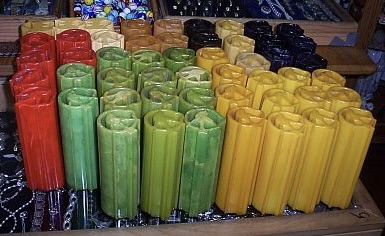
Image found on internet.
The ad also usefully illustrates the production method that would have applied to backgammon pieces. The bakelite material was cast into rods formed into shapes that could be sliced off in appropriate thicknesses into buckles, brooches, napkin rings, or backgammon pieces. Deluxe checkers would be individually carved on a lathe to deliver the various ringed patterns we find in old sets — they were not cast individually via injection molding or any other process that would leave behind telltale seams.
The collection of uncut bakelite rods displayed in an antique store at left shows plenty of shade variation within color groups. Given that rods would not have been cast in lengths yielding perfect multiples of 15, it stands to reason that some checker sets would have been made up of pieces from different rods of material. This might explain the substantial color variations we often see among checkers in vintage backgammon sets.
Is It Bakelite?
Searching for “bakelite backgammon” on eBay will turn up plenty of bakelite, but also a ton of items made of more modern plastics. Some sellers have no idea what bakelite is and are just copying the wording from successful auctions, while others knowingly misrepresent items hoping to get top “collectible” prices for more commonplace items. One of the most common misrepresentations is of later Crisloid checkers, as you see in the trio of checkers on the left in this picture. (Note that Crisloid is the name of a company/brand, not a material — Crisloid has produced checkers of various compositions, including bakelite, over time).
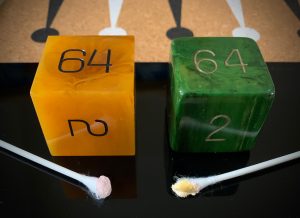
The yellowy residue on the Q-tip shows that the green cube is bakelite.
There are several popular tests to ascertain whether an item is genuine bakelite by confirming the presence of a patina, which more modern plastics and resins do not develop. Many Bakelite connoisseurs can detect a telltale chemical odor when rubbing a thumb along the piece hard enough to generate some heat, or running it under hot water, but this writer is not among them. The most reliable test is probably to dab a bit of Simichrome polish on a Q-Tip or cloth and rub the surface of your item (make sure it’s clean first). If it’s bakelite the pink Simichrome should turn yellowy.
An artisan named Nick Peterson at Save The Gammon is hand-crafting doubling cubes with a modern resin that approximates the colors and variations of classic bakelite cubes, with impressive results. As you can seen the image at right, his yellow cube does not produce the discoloring of simichrome polish that the green one does. (The aforementioned density of bakelite is also reflected in the fact that the 1.5″ green bakelite cube weighs 64 grams, compared to the 52 gram weight of the similar sized modern cube – a difference of 23% that you can feel in your hand.)
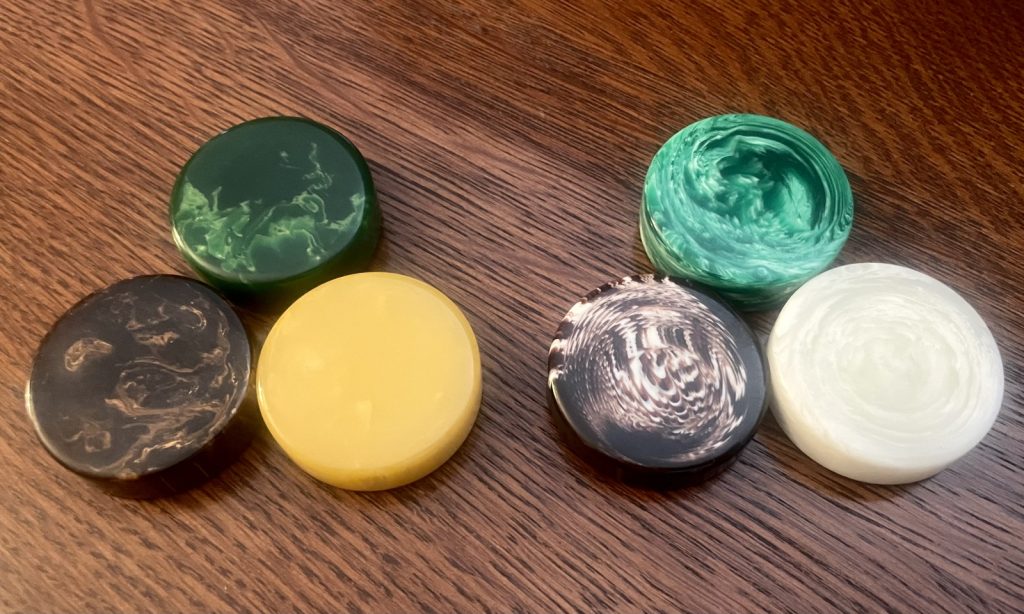
The trio on the left are bakelite, the trio on the right are a later plastic.
It is generally understood that black bakelite pieces usually do not yield a positive Simichrome test, and neither do certain ivory colored pieces, which pose a minor mystery. However, this caveat needn’t open the door to silly claims that just any old plastic checker is bakelite, and experienced collectors can generally separate the wheat from the chaff simply by looking at pictures, and so can you. Just look at the examples in the image below. The chalky white swirls in later Crisloid checkers are quite easy to differentiate from the warmer tones of bakelite, and the texture of the swirls in later plastics tends to be louder, more patterned than the mysterious, murky variations in bakelite. With practice you’ll be able to spot the differences in edge patterns as well.
There’s nothing wrong with modern acrylic or plastic checkers, and if you have difficulty telling whether backgammon pieces are bakelite or not then you should ask yourself whether it really matters. If a doubling cube doesn’t exhibit the attractive color, texture, and weight that make a bakelite piece distinctive, is a Simichrome test really going to make it more desirable? If you can’t tell whether it’s bakelite or not, what does it matter whether it’s bakelite or not? If you find two glasses of wine equally agreeable, does one become suddenly superior if you’re told it costs five or ten times as much?
One thing’s for sure — you don’t want to pay bakelite prices for plastic pieces.
Test your judgment on these seven items harvested from an eBay search.
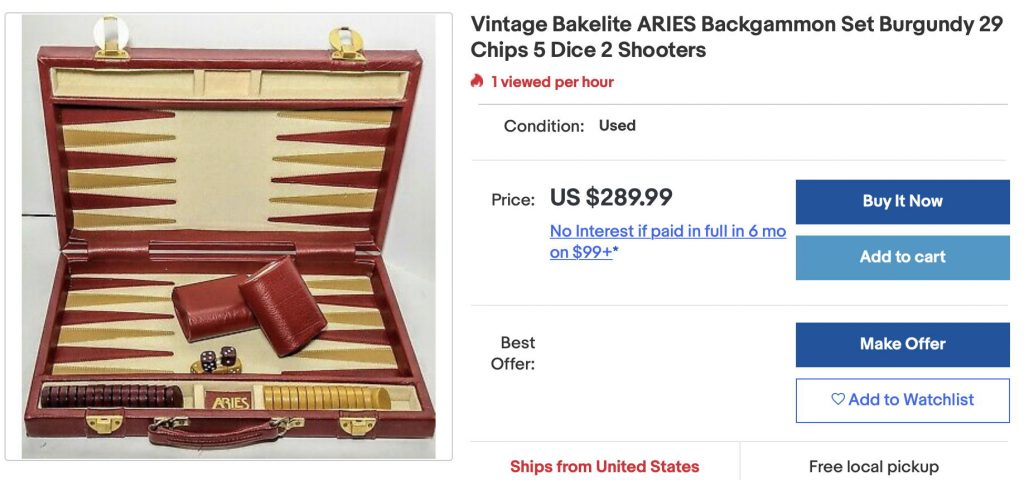
Is It bakelite?
No. Attache style Backgammon sets with fabric surfaces and checker trays are typical of the 1970’s BG heyday. With rare exceptions, bakelite checkers came in sets with cork playing fields. Anytime you see a set like this, the checkers will be an unremarkable modern plastic. $289 is a very optimistic price for a 1970’s-era set with small plastic checkers — even a quite nice-looking one like this. You might expect to spend $25 – $75 for a board like this.
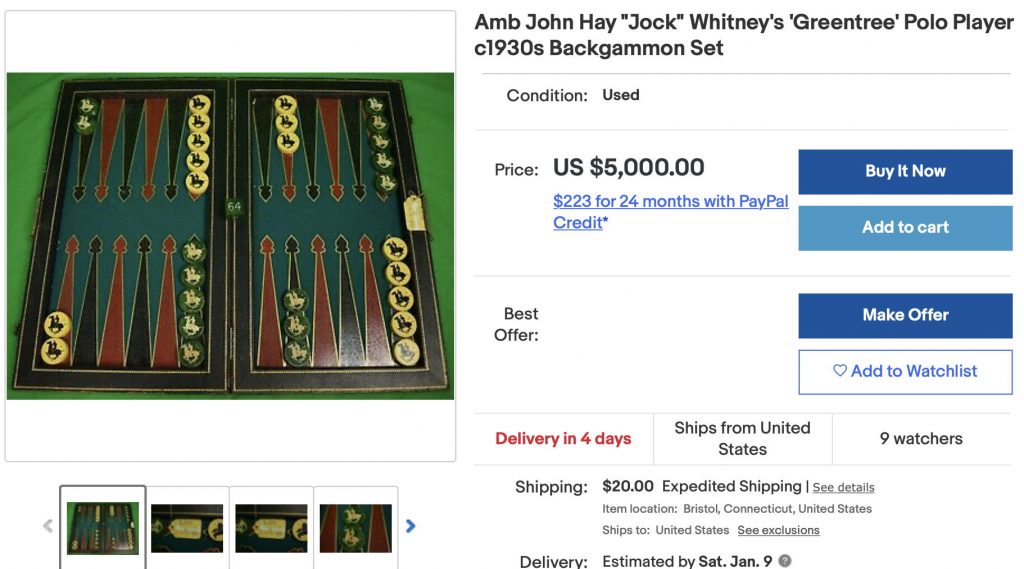
Is It bakelite?
Yes! The swirled emerald green and yellowy-ivory checkers certainly appear to be bakelite, and in the description this seller provides plenty of evidence that this set dates to the 1930’s, bakelite’s heyday. Is it worth $5000? Well, it has an interesting provenance and the polo motif is extremely unusual. Unique sets are worth whatever you can get for them — and it’s not as though you can find a similar one more cheaply elsewhere.
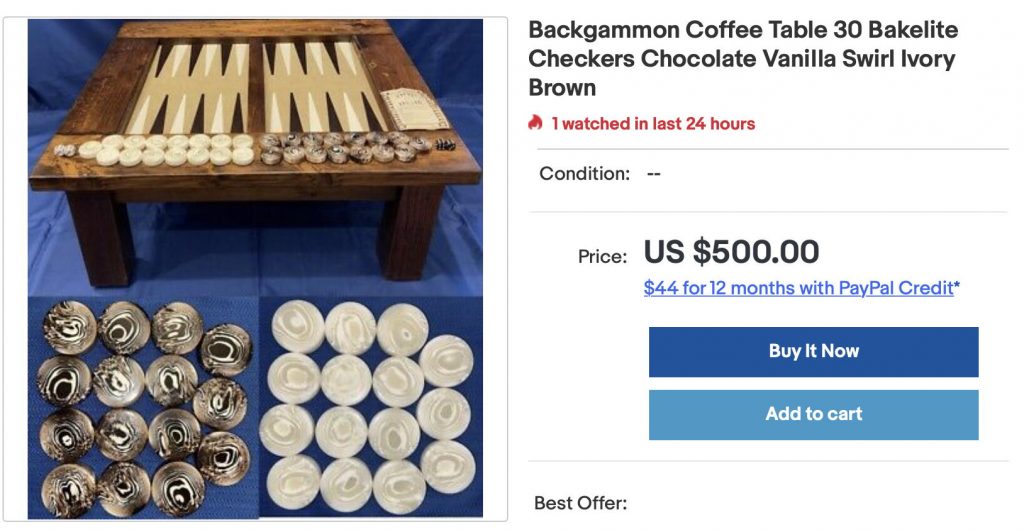
Is It bakelite?
This seller may believe these chalky white pieces are bakelite, but they’re not, and it’s not worth arguing about. If you want the table, buy it — just don’t factor bakelite checkers into the price you’re willing to pay. These Crisloid checkers date to the 80’s-90’s and should sell for perhaps $50.00 on their own — you can order newer, nicer Crisloid checker sets for $65.00.
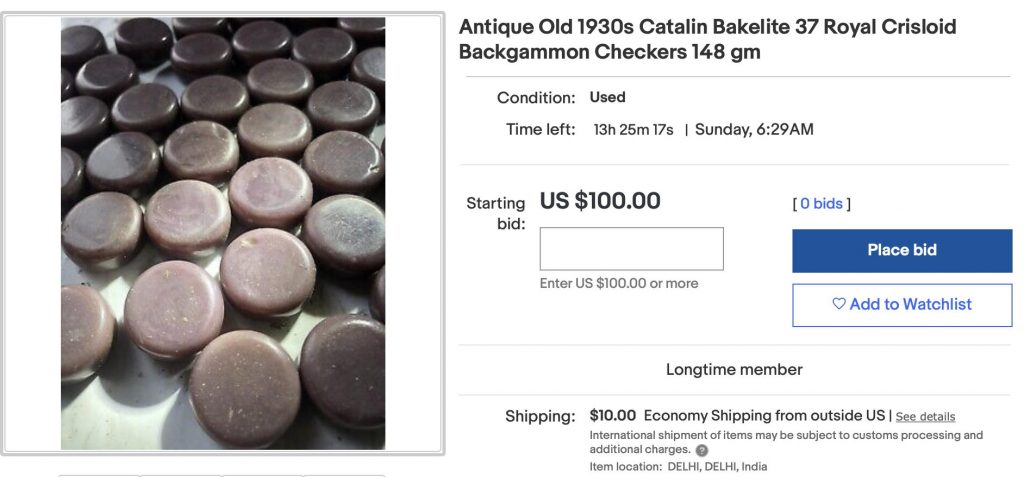
Is It bakelite?
You can see from the surfaces of these checkers that they are too soft to be bakelite, with various nicks and pits in the surface. Bakelite can be scratched or abraded (and, rarely, chipped), but not gouged. But it hardly matters whether these are bakelite or not — they don’t even look to be backgammon checkers, let alone the familiar Crisloid brand of them. Are they from the 1930’s? No reason to believe so. Oh, ebay.
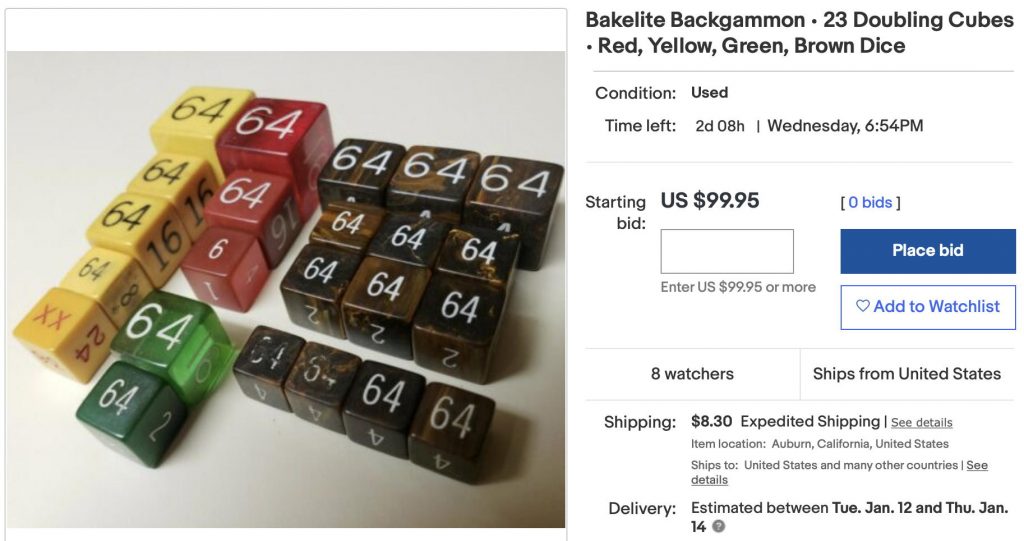
Is It bakelite?
Some are, some aren’t. The browns and yellows should probably test as bakelite, while the translucent ones may be some other, newer plastic. But just because material is bakelite doesn’t make it precious. The colors here aren’t so dazzling, and the painted-on numerals tend to wear off. But they aren’t asking bakelite prices, either, so buy ’em if you like ’em! (But ask what size they are first – how can you tell from the picture?)
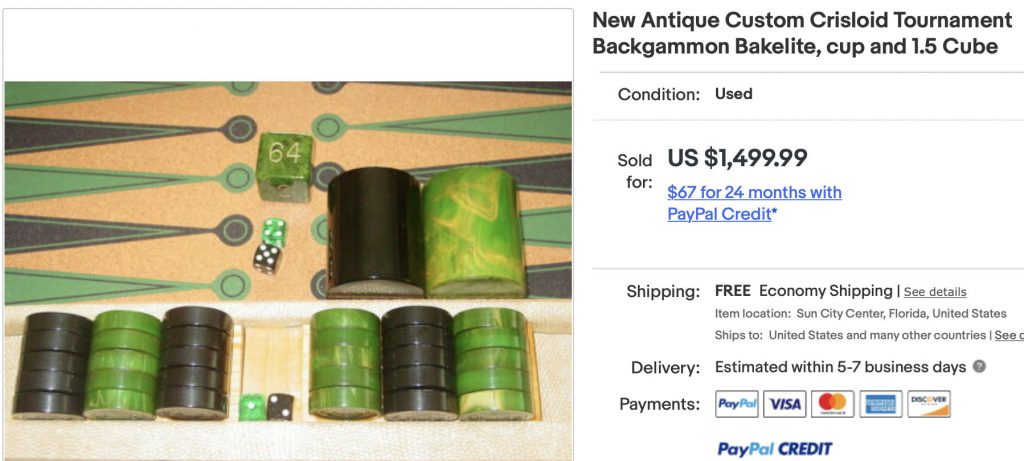
Is It bakelite?
Oh Yeah. An avid Florida collector, ‘Backgammonista’ put together this terrific combination of matching carved bakelite checkers, cups, and 1.5″ cube with a brand-new Crisloid board and precision dice. While $1499 may seem steep, she might have done even better selling these items separately: the cube alone would likely fetch $350, and that particular carved checker set might go for well over $500 these days.
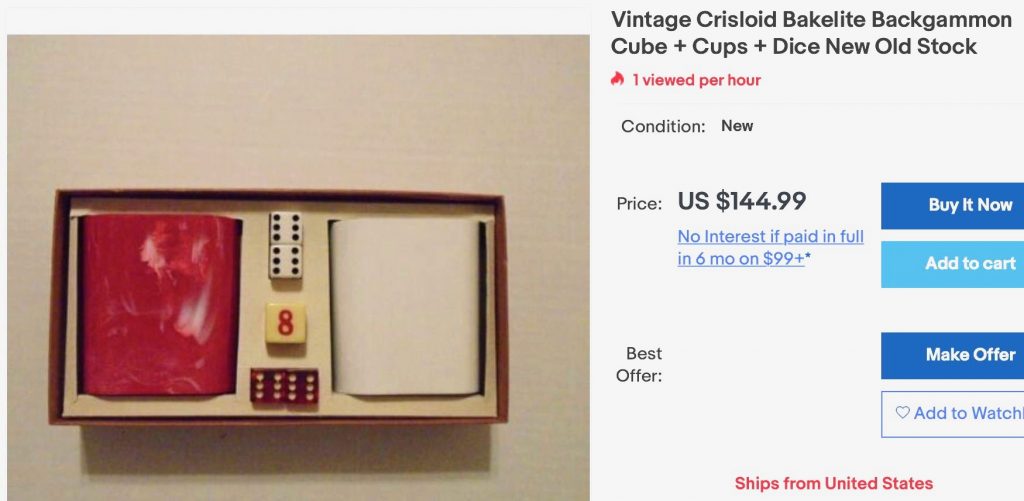
Is It bakelite?
By now you should be getting good at this: the yellow cube says yes, the chalk white swirls say no. Crisloid did a nice job simulating the bakelite look in that attractive red cup, but you could tell the difference between these cups and the ones in Item #6 with your eyes closed: bakelite cups are substantially heavier than the lightweight newer products. The cube looks to be bakelite . . . but clashes a little with the cups.
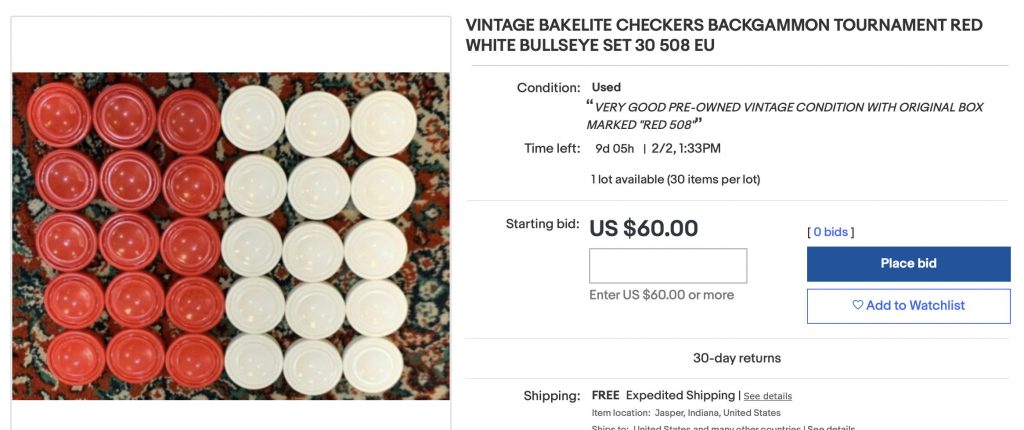
Is It bakelite?
Here’s one where you just can’t tell from a picture. There’s just enough off-white ivory warmth in the whites to suspect they may indeed be an unusual bakelite set, and the reds have a credible bakelite coloration. It’s a case where you really need to hold them in your hands to see whether they feel like bakelite. Before bidding, check the return policy, to make sure you can send them back if they turn out to be lightweight plastic. But if they fail a Simichrome bakelite test you should be able to return them in any case, as the item will have been misrepresented.
Buying Bakelite Backgammon Equipment
Unlike bakelite bracelets, which, while expensive, were made in very large quantities and can be found in great variety from all sorts of dealers, backgammon equipment is very scarce, so you may have to look for several months to find the checker set or doubling cube you are looking for. By far the most likely place to look is eBay. The more craft-oriented site Etsy occasionally has items of interest, and you can also explore various local flea markets, antique dealers, and online estate auction sites too.
Auction Prices Of course prices will vary enormously depending not just on the quality or rarity of the specific item, but also, in an auction format, on who else happens to be interested in the item that day. When browsing auction listings, remember that sellers can list items for any price they choose, and that sometimes deep-pocketed, poorly informed buyers may pay outlandish prices. You may also be competing with bakelite entrepreneurs who can recycle game pieces into decorative beads for profit. But here’s a rough guide to how things look lately (last updated February 2025).
Checker Sets (30 pieces):
- Smaller 1.5″: $150 – $250 for common colors, $500-$1000 for rare ‘blue moon’ sets.
- Standard 1.75″: $300-$450 for the more common colors (green / red /brown & yellow). Unusual colors, swirling patterns, or carvings can fetch $500 – $900+.
- Large 2″: Highly sought after in recent years, they typically go for $900 – $1500+ in any color.
Doubling Cubes / Devices
- Backgammon Matches: $75 – $150
- 1″ Doubling Cubes: $75-$125 for common colors, $150-$250 for unusual ones.
- 1.5″ Doubling Cubes: $350 – $800+ depending on unique qualities.
- 2″ Doubling Cubes & Octagons: $600 – $1000+ depending on unique qualities.
What about the playing boards themselves? Often the vintage cork boards are so worn or broken down that they don’t contribute much to the value of the pieces — but sets that have survived in nice playable condition are certainly collectible in themselves — but it’s impossible to generalize about them since so much depends on the pieces that come with them.
Bakelite Dealers There are a few individuals who often or occasionally have equipment available for purchase. Their prices will typically be at a premium to auction values as they go to substantial efforts to acquire their pieces and make them available ‘on demand’ – or perhaps because they don’t actually want to let their treasures go!
Albert Steg (New England Backgammon Club)
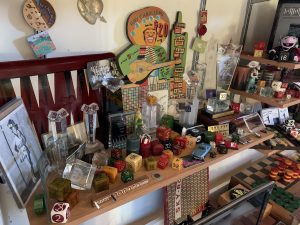 Albert is an NEBC organizer and the author of this website. A student of backgammon history, he occasionally has items to offer as his collection of equipment, books, and ephemera evolves. You can view catalogues of current items for sale here:
Albert is an NEBC organizer and the author of this website. A student of backgammon history, he occasionally has items to offer as his collection of equipment, books, and ephemera evolves. You can view catalogues of current items for sale here:
Bradford Boards
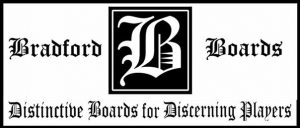 Bradford Boards is the backgammon equipment site of Michigan aficionado Brad LaPratt, who frequently has for sale a variety of unusual high-end backgammon boards of the 1970’s as well as many of the more unusual bakelite checker sets, cubes and octagons you will see pictured in the images galleries below. You can contact Brad via his website, or call him at (517) 974-6327.
Bradford Boards is the backgammon equipment site of Michigan aficionado Brad LaPratt, who frequently has for sale a variety of unusual high-end backgammon boards of the 1970’s as well as many of the more unusual bakelite checker sets, cubes and octagons you will see pictured in the images galleries below. You can contact Brad via his website, or call him at (517) 974-6327.
Nancy Backgammonista
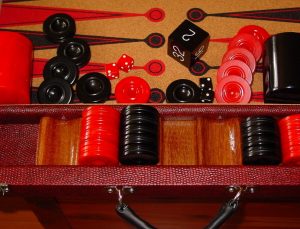 A resident of Sun City Center in Florida, Nancy has been offering eye-popping vintage backgammon equipment (like the set you see here!) on eBay for years, though she has abandoned the site due to new demands for banking information they are requiring of sellers. If you’d like to contact Nancy with your wish list or to ask what she has to offer, you can email her at Bronx61@aol.com.
A resident of Sun City Center in Florida, Nancy has been offering eye-popping vintage backgammon equipment (like the set you see here!) on eBay for years, though she has abandoned the site due to new demands for banking information they are requiring of sellers. If you’d like to contact Nancy with your wish list or to ask what she has to offer, you can email her at Bronx61@aol.com.
Frank Echols
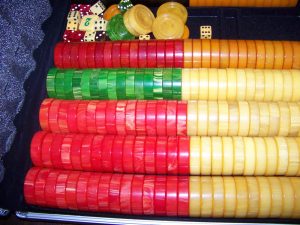 Frank Echols lives in New Jersey and is an avid collector of all things backgammon and a frequent seller of bakelite pieces. You can email him at frankechols@hotmail.com.
Frank Echols lives in New Jersey and is an avid collector of all things backgammon and a frequent seller of bakelite pieces. You can email him at frankechols@hotmail.com.
Bakelite gallery: Doublers & Accessories
Bakelite gallery: Checkers
Bakelite gallery: Sets
1930’s backgammon boards employed very simple color schemes. A neutral tan cork field provided natural contrast with points in black & white or perhaps using just one of the checker colors as an accent — so at least one of the point colors is invariably black or white. A good color scheme provides a quiet stage for the checkers to dazzle, rather than competing with them for attention — so to show off your bakelite to best effect, you’re best off keeping the color scheme simple, and closely matching a single accent color to one of the checker colors.

